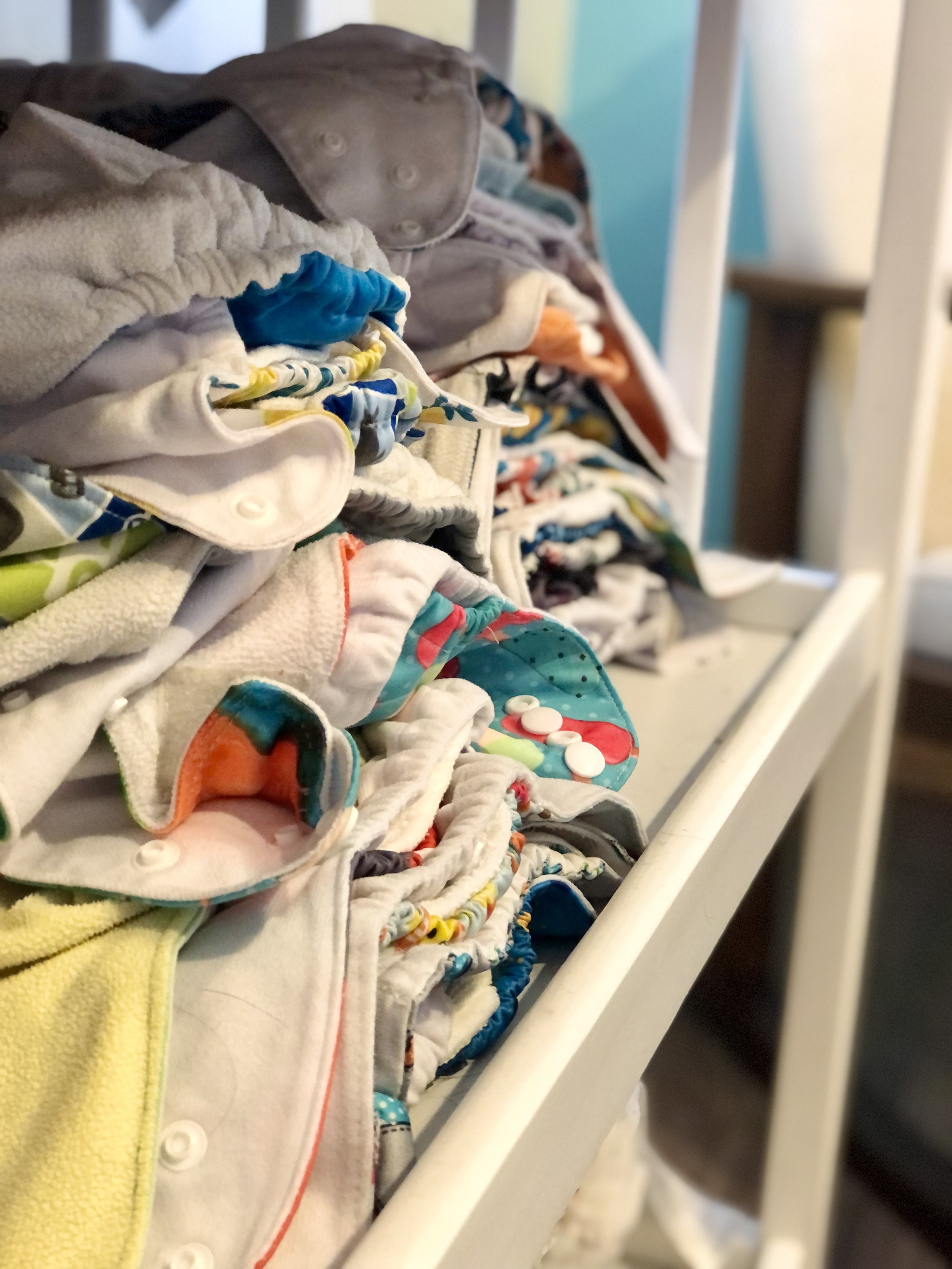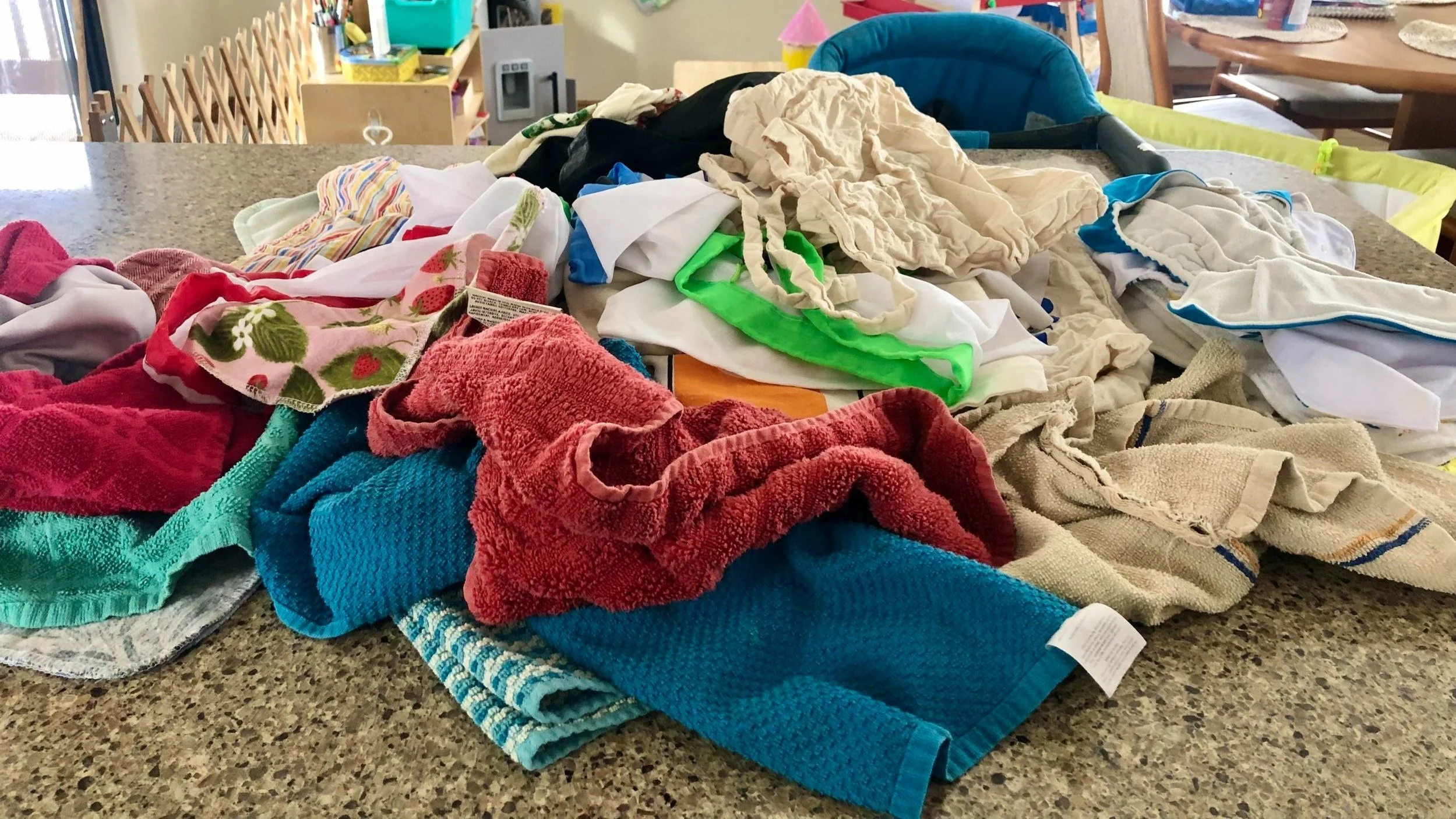Reusables: Diapers, towels & bags
My family has ebbed and flowed with reusable and disposable products in our zero waste journey. The cycle looks something like this: getting a surge of energy, buying reusable products, starting out with strong dedication, drowning in overwhelm and feelings of failure, and reverting to disposables in survival mode.
That’s because the zero waste journey isn’t so much about skipping the plastic bag at check-out as much as it’s about building new habits and systems into your lifestyle (which is hard!). Additionally, the external landscape is always shifting, making it really difficult to determine what the best eco-conscious choices are, particularly when you have no time to sort it out.
“I heard that reusable diapers actually use more water, and disposables are better,” said my husband recently. And then the NYT put out a haunting article effectively shaming all of us cotton tote carrying, eco-conscious consumers, because the life cycle assessment (LCA) of cotton bags is actually quite bad compared to the disposable plastic ones.
So what’s best, reusables or disposables? And then, how do you make it last? This blog post pulls together some satisfying evidence on the reusable/disposable quandary and our lessons learned as we finally solidified reusable systems. I hope it helps!
Our mixed and matched grocery and produce bag supply acquired from all over everywhere.
Reusables vs. Disposables
My high school art teacher would try to catch us off guard by asking, “Is this a light color or a dark color?” The catch was that we were always wrong unless we responded, “Compared to what?” Meaning, everything is relative. Nothing can be light or dark, better or worse, right or wrong, until it’s in context - which is always changing.
And that’s the deal with reusables vs. disposables as well. There are, though, a few hard and fast guidelines that will always help you to make the best eco-conscious choice.
Every product must be evaluated in terms of its whole life cycle assessment (LCA)
Let’s look at diapers, for example. Sure, disposables are used once before going to the landfill, but cloth diapers will use a substantial amount of water to be laundered so many times, right? Once we account for all the resources, energy and water that are used from extracting the the raw materials (cradle) to the product’s end-of-life (grave), however, total impact becomes clearer.
Most cloth vs. disposable diaper debates point to a single study from the UK which determined that cloth diapers are slightly better once accounting for the entire LCAs. Vox breaks it down here.
Each person’s situation is fairly unique
Let’s dive into that cotton tote quandary from the NYT article, which determined that a cotton tote needs to be used 20,000 times to offset its production impact. Womp womp. (*Note: this Lifehacker article breaks down the data from the original study to show that 75 uses are more accurately needed to offset production. It’s still a lot.)
What if your town has banned single-use bags, or what if you already have 30 cotton totes in use? Should you go buy new polyester bags? No! There are no strict zero waste rules. Rather, use the data and your unique context to guide your own net zero journey.
Less is more; straight up
Paper, plastic or cotton? Honestly, none is best. Obviously, we do need a constant flow of materials, food, water, and energy to keep our lives running. But can we learn to become genuinely comfortable with less?
Finally after considerable anguish, I put my foot down on acquiring material stuff at all. I sent a very difficult message to all members of my family thanking them for their love and support . . . and kindly requesting that they no longer gift us any more material stuff. It turned into a conversation with each person around what gifts look like if not stuff, how my children will cope with no more stuff, and, of course, caveats.
Because, after a few months they all assumed I had been having one of those fleeting moments of environmental angst and tried to rationalize with me, “Books aren’t considered stuff, are they?” or “The baby needs new clothes now, nothing fits him!” or “Surely, you just meant de-clutter. Once you make some space, I have some curtains I think you’d like.” I again stood my ground and continued the conversation. I clarified that we’d look for second-hand goods first, but we’d let them know other ways they can help and be a part of our lives.
Zero waste is an evolving journey that has ripple effects whether or not we can see or measure them. The aim is to stay the course and keep recommitting when we fall out of orbit!
Build Your System: Lessons Learned
I stuff each cloth pocket diaper with an insert when it comes out of the wash so they are all ready to go.
Have Enough Reusable Products
A big barrier for us was just not having enough resuables, so we kept defaulting to disposables.
We tried cloth diapering with my first child and failed. It was too poopy. We only had six diapers. I could never get ahead on laundry. My husband wouldn’t do it. My mom wouldn’t do it. I threw in the towel (pun intended ;).
Now, we have plenty of resuables to keep our whole home operation moving, and we never have to run to the store to get disposables. This is our supply for a family of four:
Cloth Paper Towels - 36
I actually bought these to make the transition away from paper towels easier. And it was! Marley’s Monsters unpaper towels come in sets of 12. Kids love the patterns and they stick to a roll just like paper towels. We rinse them out and keep using each for a few days at a time.
Cloth Napkins - 25
These I bought as well, and they’re nothing fancy. The key is to have enough to host guests for a few days at a time without running the laundry.
Rando Cloths - 50
A whole drawer of burp cloths, wash cloths, & muslin cloths used for all extraneous uses: spills, messes, throw-up, bath time, doggy diarrhea, etc.
Grocery & Produce Bags - 30
We keep 2 grocery sets that shuffle between the cars and pantry. Each set has 5-6 large capacity bags and about 10-15 smaller produce bags. This way there’s always a “set” ready to go while various produce bags are in the fridge or laundry.
Cloth Diapers - 25
These are all pocket diapers. Half I got used, and half I bought. Additionally, we have 35 inserts allowing us to reuse that outer diaper when insert is soiled. (We also use disposable bamboo liners, which are a game changer!)
Floor Rags - 15ish
A pile of cloths under the sink and comprised of anything torn, stained, or ratted. Any cloth above when wrecked goes into this pile.
Our rando cloth drawer for anything and everything is super essential. I got most these up from a friend getting rid of them.
Get Your Reusables Used
Trust me, I know it’s easier to order some cheap stuff off Amazon or pick up some discounted cloths from Home Goods.
However, increasing the number of uses in a product’s life cycle is what makes it more environmentally impactful than its disposable counter part.
Let’s revisit the cotton tote bag scenario for example. Even though the cotton tote required far more input than the standard LDPE single-use plastic bag, that cotton tote can be used for 50 years and displace the need of 20,000 LDPE bags. Essentially, the more uses you can get out of a product the better.
Some lovely person hand-made dozens of my baby burp cloths, and I can only imagine how many babies have used them! This is how my grandparents used to live. I don’t know why it fell out of style.
Where do you find used reusables?
• Zero waste or parenting Facebook groups
• Ask other parents for hand-me-downs
• Put out a call out to friend networks on social media
• Goodwill or other thrift stores
Regular wash of reusables that keeps the cycle churning. We do a couple of these per week.
Keep a Constant Washing Cycle Moving
A second big barrier for our family was the Myth of Arrival. In my mind I kept trying to attain some state of completeness in which all the reusables would be laundered and folded in place.
Reality: that’s never going to happen. Now I strive for a dynamic equilibrium where reusables are in constant motion.
We keep a container under the sink for all soiled kitchen towels and bags, and we keep a dry bag in the baby’s room for soiled diapers. This way, reusables are in constant circulation with a third of them dirty in baskets around the house, a third in the laundry room mid-washing, and a third either clean in drawers or waiting to be put away.
Additionally, a core factor that gives reusables a lower environmental impact than disposables is the consumer’s ability to affect their lifecycles. That means that by choosing how you use, wash, and dry the products is a game-changer in lowering their negative impact. Revisiting the UK cloth diaper study, the study concluded that if you launder your diapers on cool and mostly line-dry them, then reusables are definitively more environmentally effective than disposables.
*Note: The UK study included a set of 42 cloth diapers per child, which seems like a lot! Using just half that number would double the environmental impact of reusables.
Solve for Your Unique Barriers
We all have our own barriers to adopting new lifestyle habits that make our experiences unique. Taking the introspective time to figure out your personal impediments is key.
One of my mental blocks was feeling like I needed a clean laundry room. What if people came to visit and my laundry room wasn’t tidy? Seriously, that was my holdup. I had to get over it. I resolved that the laundry room is made for cleaning!
Surprisingly, I had an emotional block that was my mothers. My mom, step-mom, and mom-in-law would come over to visit and refuse to get on board with our zero waste journey. They’d say things like, “I just don’t know where the cloth is, so I’m using paper. Just so you know! I’m using paper!” I’d concede, get frustrated, and feel like giving up. I had to realize that I’m responsible for my own home, step into my leadership pants, and stand my ground.
Lastly, I had to get over my doubt and discouragement. The zero waste journey is not a zero sum game. Meaning, we aren’t losing the climate fight until x-tons of carbon are pulled from the atmosphere. Evolving hearts and minds, in addition to each of these small lifestyle changes, is a necessary, and arguably, even larger part of the journey.
We hope these tips and recommendations for reusables will help you along your zero waste journey! Got questions? Leave them below in the comments.







